2020 Hyundai Tucson weight
[x] Cancel search: weightPage 9 of 637
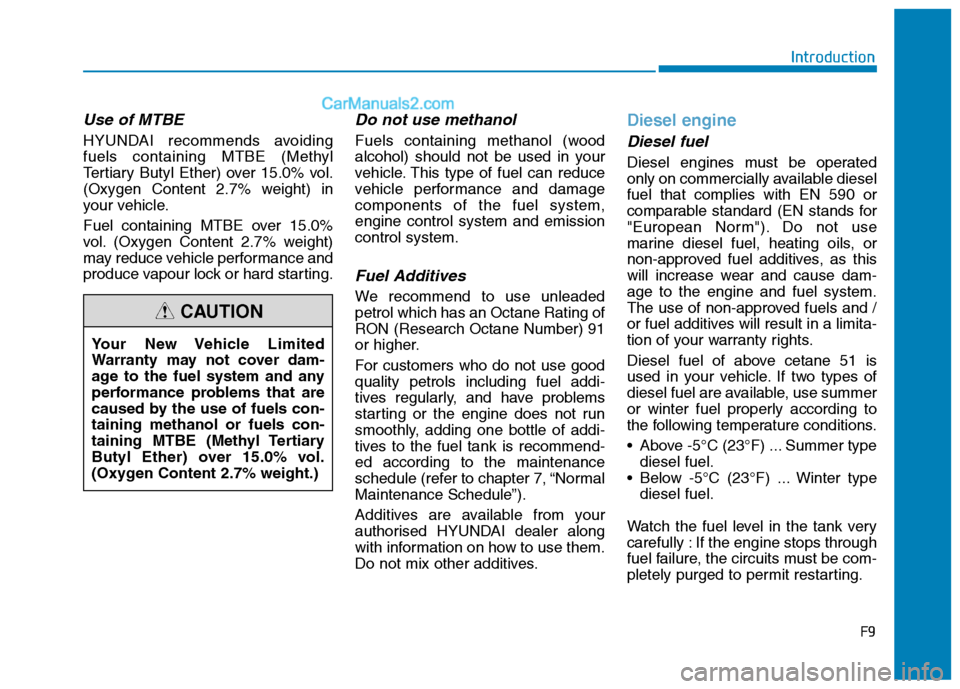
F9
Introduction
Use of MTBE
HYUNDAI recommends avoiding
fuels containing MTBE (Methyl
Tertiary Butyl Ether) over 15.0% vol.
(Oxygen Content 2.7% weight) in
your vehicle.
Fuel containing MTBE over 15.0%
vol. (Oxygen Content 2.7% weight)
may reduce vehicle performance and
produce vapour lock or hard starting.
Do not use methanol
Fuels containing methanol (wood
alcohol) should not be used in your
vehicle. This type of fuel can reduce
vehicle performance and damage
components of the fuel system,
engine control system and emission
control system.
Fuel Additives
We recommend to use unleaded
petrol which has an Octane Rating of
RON (Research Octane Number) 91
or higher.
For customers who do not use good
quality petrols including fuel addi-
tives regularly, and have problems
starting or the engine does not run
smoothly, adding one bottle of addi-
tives to the fuel tank is recommend-
ed according to the maintenance
schedule (refer to chapter 7, “Normal
Maintenance Schedule”).
Additives are available from your
authorised HYUNDAI dealer along
with information on how to use them.
Do not mix other additives.
Diesel engine
Diesel fuel
Diesel engines must be operated
only on commercially available diesel
fuel that complies with EN 590 or
comparable standard (EN stands for
"European Norm"). Do not use
marine diesel fuel, heating oils, or
non-approved fuel additives, as this
will increase wear and cause dam-
age to the engine and fuel system.
The use of non-approved fuels and /
or fuel additives will result in a limita-
tion of your warranty rights.
Diesel fuel of above cetane 51 is
used in your vehicle. If two types of
diesel fuel are available, use summer
or winter fuel properly according to
the following temperature conditions.
Above -5°C (23°F) ... Summer type
diesel fuel.
Below -5°C (23°F) ... Winter type
diesel fuel.
Watch the fuel level in the tank very
carefully : If the engine stops through
fuel failure, the circuits must be com-
pletely purged to permit restarting. Your New Vehicle Limited
Warranty may not cover dam-
age to the fuel system and any
performance problems that are
caused by the use of fuels con-
taining methanol or fuels con-
taining MTBE (Methyl Tertiary
Butyl Ether) over 15.0% vol.
(Oxygen Content 2.7% weight.)
CAUTION
Page 55 of 637
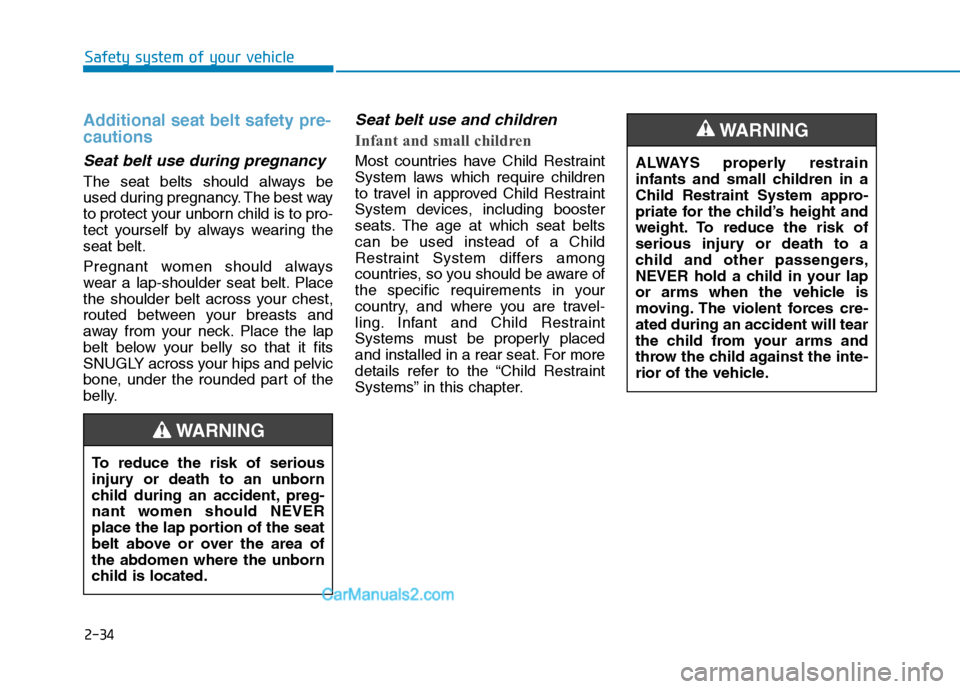
2-34
Safety system of your vehicle
Additional seat belt safety pre-
cautions
Seat belt use during pregnancy
The seat belts should always be
used during pregnancy. The best way
to protect your unborn child is to pro-
tect yourself by always wearing the
seat belt.
Pregnant women should always
wear a lap-shoulder seat belt. Place
the shoulder belt across your chest,
routed between your breasts and
away from your neck. Place the lap
belt below your belly so that it fits
SNUGLY across your hips and pelvic
bone, under the rounded part of the
belly.
Seat belt use and children
Infant and small children
Most countries have Child Restraint
System laws which require children
to travel in approved Child Restraint
System devices, including booster
seats. The age at which seat belts
can be used instead of a Child
Restraint System differs among
countries, so you should be aware of
the specific requirements in your
country, and where you are travel-
ling. Infant and Child Restraint
Systems must be properly placed
and installed in a rear seat. For more
details refer to the “Child Restraint
Systems” in this chapter.ALWAYS properly restrain
infants and small children in a
Child Restraint System appro-
priate for the child’s height and
weight. To reduce the risk of
serious injury or death to a
child and other passengers,
NEVER hold a child in your lap
or arms when the vehicle is
moving. The violent forces cre-
ated during an accident will tear
the child from your arms and
throw the child against the inte-
rior of the vehicle.
WARNING
To reduce the risk of serious
injury or death to an unborn
child during an accident, preg-
nant women should NEVER
place the lap portion of the seat
belt above or over the area of
the abdomen where the unborn
child is located.
WARNING
Page 56 of 637
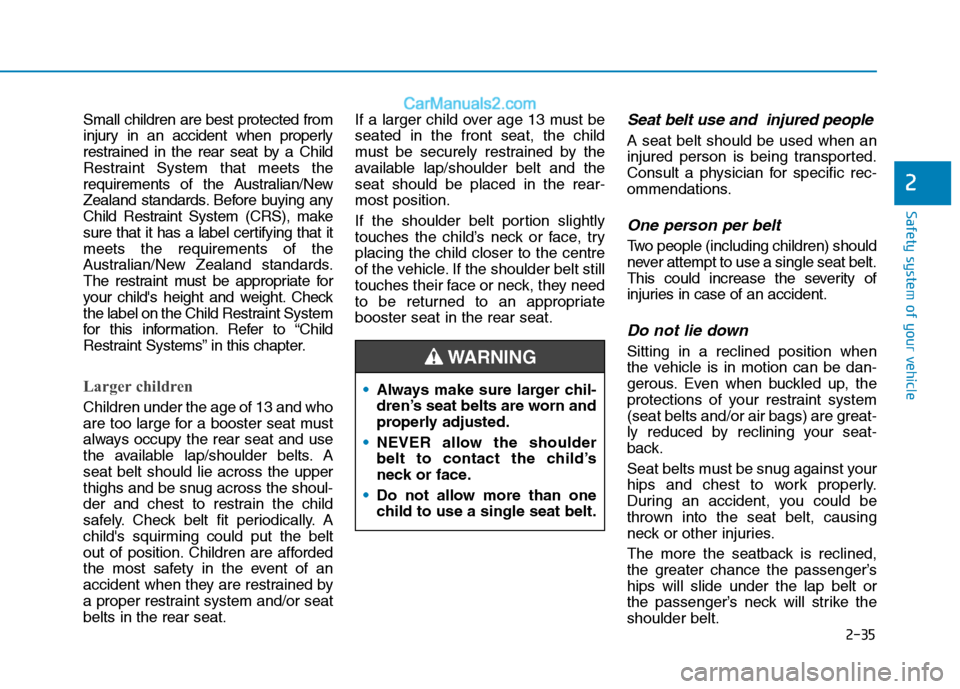
2-35
Safety system of your vehicle
2
Small children are best protected from
injury in an accident when properly
restrained in the rear seat by a Child
Restraint System that meets the
requirements of the Australian/New
Zealand standards. Before buying any
Child Restraint System (CRS), make
sure that it has a label certifying that it
meets the requirements of the
Australian/New Zealand standards.
The restraint must be appropriate for
your child's height and weight. Check
the label on the Child Restraint System
for this information. Refer to “Child
Restraint Systems” in this chapter.
Larger children
Children under the age of 13 and who
are too large for a booster seat must
always occupy the rear seat and use
the available lap/shoulder belts. A
seat belt should lie across the upper
thighs and be snug across the shoul-
der and chest to restrain the child
safely. Check belt fit periodically. A
child's squirming could put the belt
out of position. Children are afforded
the most safety in the event of an
accident when they are restrained by
a proper restraint system and/or seat
belts in the rear seat.If a larger child over age 13 must be
seated in the front seat, the child
must be securely restrained by the
available lap/shoulder belt and the
seat should be placed in the rear-
most position.
If the shoulder belt portion slightly
touches the child’s neck or face, try
placing the child closer to the centre
of the vehicle. If the shoulder belt still
touches their face or neck, they need
to be returned to an appropriate
booster seat in the rear seat.
Seat belt use and injured people
A seat belt should be used when an
injured person is being transported.
Consult a physician for specific rec-
ommendations.
One person per belt
Two people (including children) should
never attempt to use a single seat belt.
This could increase the severity of
injuries in case of an accident.
Do not lie down
Sitting in a reclined position when
the vehicle is in motion can be dan-
gerous. Even when buckled up, the
protections of your restraint system
(seat belts and/or air bags) are great-
ly reduced by reclining your seat-
back.
Seat belts must be snug against your
hips and chest to work properly.
During an accident, you could be
thrown into the seat belt, causing
neck or other injuries.
The more the seatback is reclined,
the greater chance the passenger’s
hips will slide under the lap belt or
the passenger’s neck will strike the
shoulder belt. Always make sure larger chil-
dren’s seat belts are worn and
properly adjusted.
NEVER allow the shoulder
belt to contact the child’s
neck or face.
Do not allow more than one
child to use a single seat belt.WARNING
Page 58 of 637

2-37
Safety system of your vehicle
2
Children always in the rear
Children under the age of 13 must
always ride in the rear seats and
must always be properly restrained
to minimise the risk of injury in an
accident, sudden stop or sudden
manoeuvre. According to accident
statistics, children are safer when
properly restrained in the rear seats
than in the front seat. Children too
large for a Child Restraint System
must use the seat belts provided.Most countries have Child Restraint
System which require children to
travel in approved Child Restraint
System. The laws governing the age
or height/weight restrictions at which
seat belts can be used instead of
Child Restraint System differs
among countries, so you should be
aware of the specific requirements in
your country, and where you are trav-
elling.
Child Restraint Systems must be
properly placed and installed in the
rear seat. You must use a commer-
cially available Child Restraint
System that meets the requirements
of the Australian/New Zealand stan-
dards.
Child Restraint Systems are general-
ly designed to be secured in a vehi-
cle seat by lap belt or the lap belt
portion of a lap/shoulder belt, or by a
top-tether and/or ISOFIX anchorage
in the rear seats of the vehicle.
Child Restraint System (CRS)
always in the rear seat
Infants and younger children must be
restrained in an appropriate rear-
ward-facing or forward-facing CRS
that has first been properly secured
to the rear seat of the vehicle. Read
and comply with the instructions for
installation and use provided by the
manufacturer of the Child Restraint
System.
C CH
HI
IL
LD
D
R
RE
ES
ST
TR
RA
AI
IN
NT
T
S
SY
YS
ST
TE
EM
M
(
(C
CR
RS
S)
)
Always properly restrain chil-
dren in the rear seats of the
vehicle.
Children of all ages are safer
when restrained in the rear seat.
A child riding in the front pas-
senger seat can be forcefully
struck by an inflating air bag
resulting in SERIOUS INJURY
or DEATH.
WARNING
Page 59 of 637
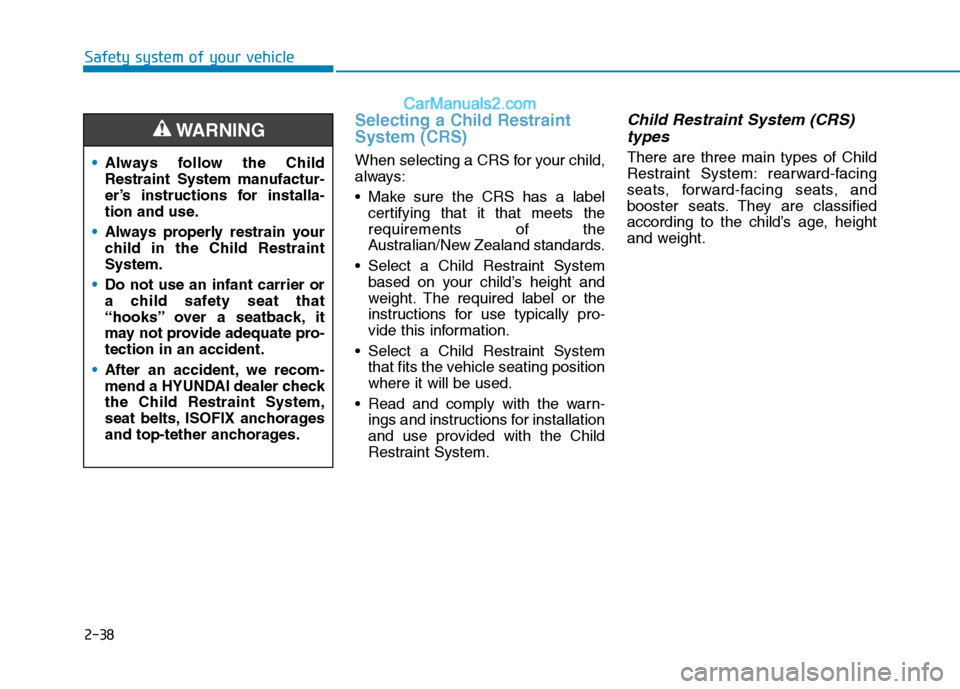
2-38
Safety system of your vehicle
Selecting a Child Restraint
System (CRS)
When selecting a CRS for your child,
always:
Make sure the CRS has a label
certifying that it that meets the
requirements of the
Australian/New Zealand standards.
Select a Child Restraint System
based on your child’s height and
weight. The required label or the
instructions for use typically pro-
vide this information.
Select a Child Restraint System
that fits the vehicle seating position
where it will be used.
Read and comply with the warn-
ings and instructions for installation
and use provided with the Child
Restraint System.
Child Restraint System (CRS)
types
There are three main types of Child
Restraint System: rearward-facing
seats, forward-facing seats, and
booster seats. They are classified
according to the child’s age, height
and weight.Always follow the Child
Restraint System manufactur-
er’s instructions for installa-
tion and use.
Always properly restrain your
child in the Child Restraint
System.
Do not use an infant carrier or
a child safety seat that
“hooks” over a seatback, it
may not provide adequate pro-
tection in an accident.
After an accident, we recom-
mend a HYUNDAI dealer check
the Child Restraint System,
seat belts, ISOFIX anchorages
and top-tether anchorages.
WARNING
Page 60 of 637
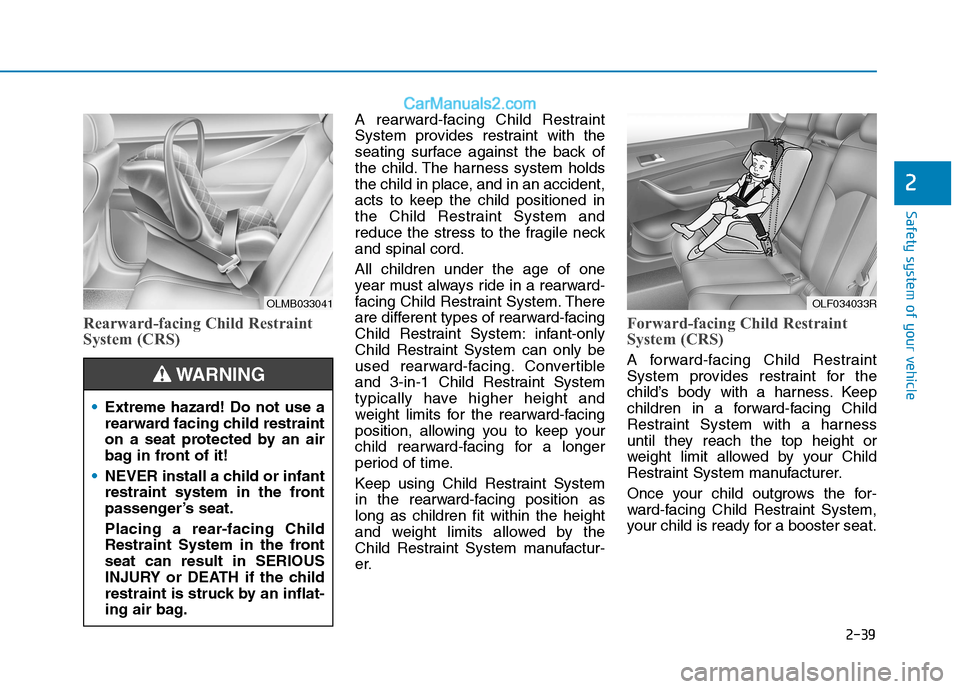
2-39
Safety system of your vehicle
2
Rearward-facing Child Restraint
System (CRS)
A rearward-facing Child Restraint
System provides restraint with the
seating surface against the back of
the child. The harness system holds
the child in place, and in an accident,
acts to keep the child positioned in
the Child Restraint System and
reduce the stress to the fragile neck
and spinal cord.
All children under the age of one
year must always ride in a rearward-
facing Child Restraint System. There
are different types of rearward-facing
Child Restraint System: infant-only
Child Restraint System can only be
used rearward-facing. Convertible
and 3-in-1 Child Restraint System
typically have higher height and
weight limits for the rearward-facing
position, allowing you to keep your
child rearward-facing for a longer
period of time.
Keep using Child Restraint System
in the rearward-facing position as
long as children fit within the height
and weight limits allowed by the
Child Restraint System manufactur-
er.
Forward-facing Child Restraint
System (CRS)
A forward-facing Child Restraint
System provides restraint for the
child’s body with a harness. Keep
children in a forward-facing Child
Restraint System with a harness
until they reach the top height or
weight limit allowed by your Child
Restraint System manufacturer.
Once your child outgrows the for-
ward-facing Child Restraint System,
your child is ready for a booster seat.
OLF034033ROLMB033041
Extreme hazard! Do not use a
rearward facing child restraint
on a seat protected by an air
bag in front of it!
NEVER install a child or infant
restraint system in the front
passenger’s seat.
Placing a rear-facing Child
Restraint System in the front
seat can result in SERIOUS
INJURY or DEATH if the child
restraint is struck by an inflat-
ing air bag.
WARNING
Page 139 of 637
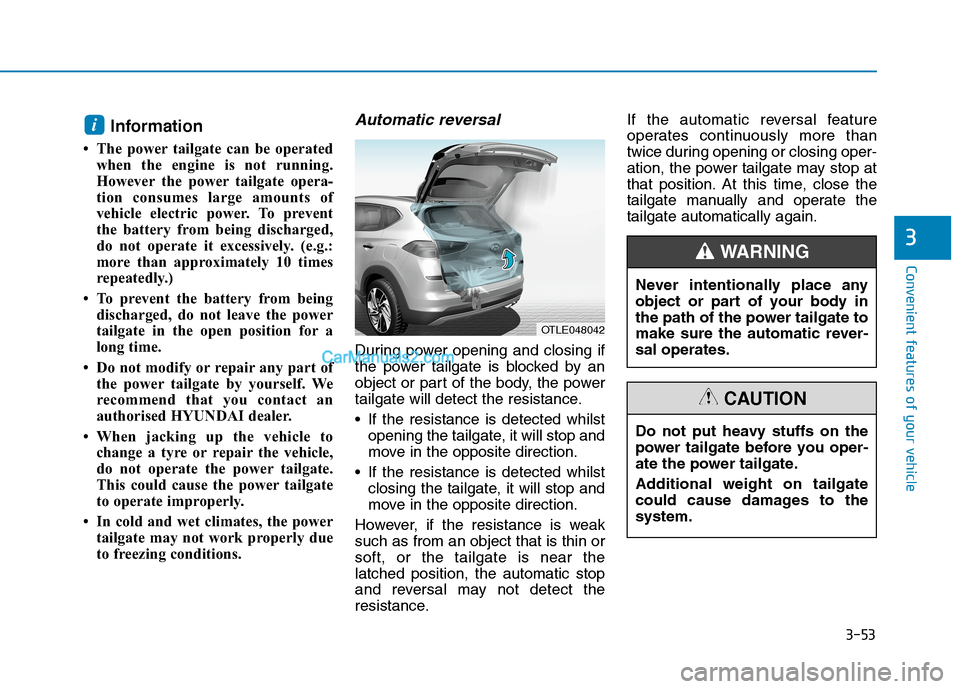
3-53
Convenient features of your vehicle
3
Information
• The power tailgate can be operated
when the engine is not running.
However the power tailgate opera-
tion consumes large amounts of
vehicle electric power. To prevent
the battery from being discharged,
do not operate it excessively. (e.g.:
more than approximately 10 times
repeatedly.)
• To prevent the battery from being
discharged, do not leave the power
tailgate in the open position for a
long time.
• Do not modify or repair any part of
the power tailgate by yourself. We
recommend that you contact an
authorised HYUNDAI dealer.
• When jacking up the vehicle to
change a tyre or repair the vehicle,
do not operate the power tailgate.
This could cause the power tailgate
to operate improperly.
• In cold and wet climates, the power
tailgate may not work properly due
to freezing conditions.
Automatic reversal
During power opening and closing if
the power tailgate is blocked by an
object or part of the body, the power
tailgate will detect the resistance.
If the resistance is detected whilst
opening the tailgate, it will stop and
move in the opposite direction.
If the resistance is detected whilst
closing the tailgate, it will stop and
move in the opposite direction.
However, if the resistance is weak
such as from an object that is thin or
soft, or the tailgate is near the
latched position, the automatic stop
and reversal may not detect the
resistance.If the automatic reversal feature
operates continuously more than
twice during opening or closing oper-
ation, the power tailgate may stop at
that position. At this time, close the
tailgate manually and operate the
tailgate automatically again.
i
OTLE048042
Never intentionally place any
object or part of your body in
the path of the power tailgate to
make sure the automatic rever-
sal operates.
WARNING
Do not put heavy stuffs on the
power tailgate before you oper-
ate the power tailgate.
Additional weight on tailgate
could cause damages to the
system.
CAUTION
Page 203 of 637
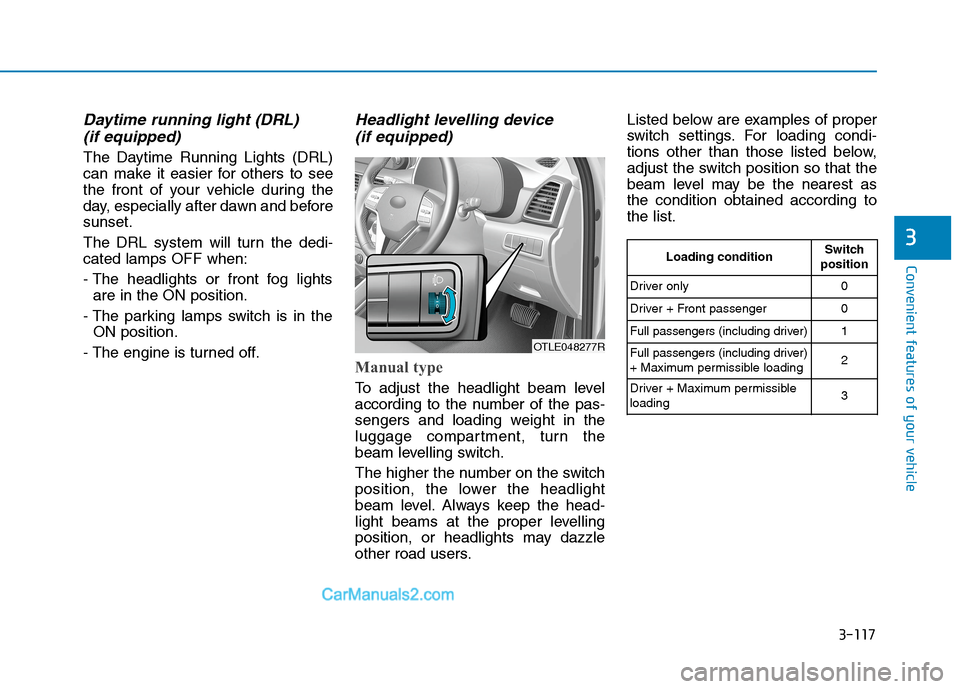
3-117
Convenient features of your vehicle
3
Daytime running light (DRL)
(if equipped)
The Daytime Running Lights (DRL)
can make it easier for others to see
the front of your vehicle during the
day, especially after dawn and before
sunset.
The DRL system will turn the dedi-
cated lamps OFF when:
- The headlights or front fog lights
are in the ON position.
- The parking lamps switch is in the
ON position.
- The engine is turned off.
Headlight levelling device
(if equipped)
Manual type
To adjust the headlight beam level
according to the number of the pas-
sengers and loading weight in the
luggage compartment, turn the
beam levelling switch.
The higher the number on the switch
position, the lower the headlight
beam level. Always keep the head-
light beams at the proper levelling
position, or headlights may dazzle
other road users.Listed below are examples of proper
switch settings. For loading condi-
tions other than those listed below,
adjust the switch position so that the
beam level may be the nearest as
the condition obtained according to
the list.
OTLE048277R
Loading conditionSwitch
position
Driver only 0
Driver + Front passenger 0
Full passengers (including driver) 1
Full passengers (including driver)
+ Maximum permissible loading2
Driver + Maximum permissible
loading 3